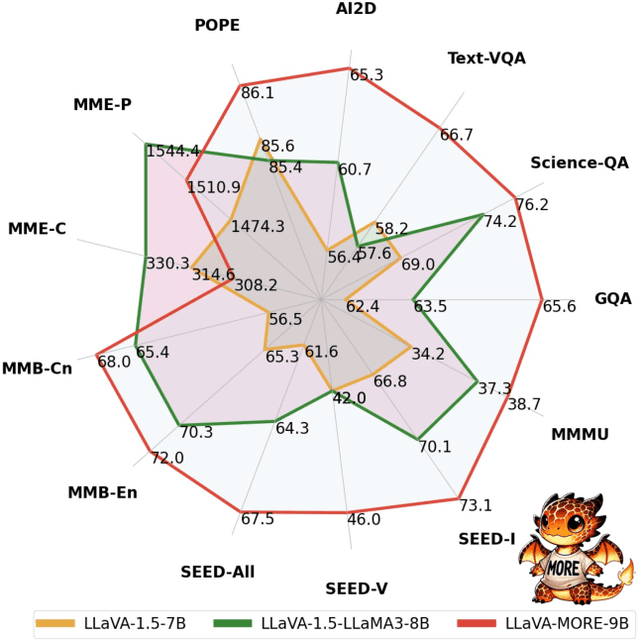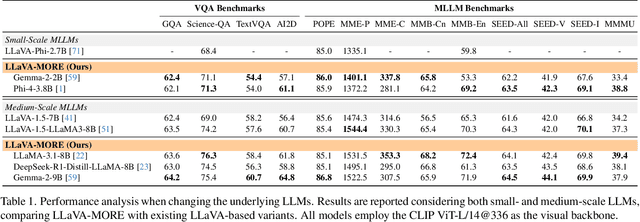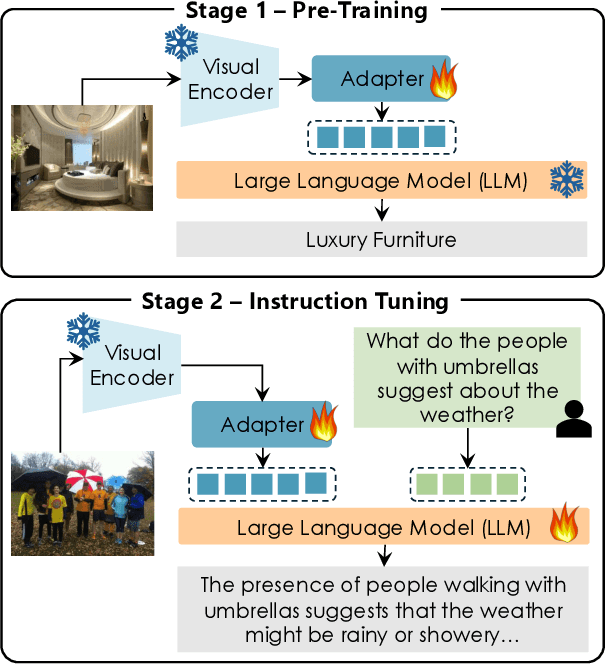Lorenzo Baraldi
Recurrence Meets Transformers for Universal Multimodal Retrieval
Sep 10, 2025Abstract:With the rapid advancement of multimodal retrieval and its application in LLMs and multimodal LLMs, increasingly complex retrieval tasks have emerged. Existing methods predominantly rely on task-specific fine-tuning of vision-language models and are limited to single-modality queries or documents. In this paper, we propose ReT-2, a unified retrieval model that supports multimodal queries, composed of both images and text, and searches across multimodal document collections where text and images coexist. ReT-2 leverages multi-layer representations and a recurrent Transformer architecture with LSTM-inspired gating mechanisms to dynamically integrate information across layers and modalities, capturing fine-grained visual and textual details. We evaluate ReT-2 on the challenging M2KR and M-BEIR benchmarks across different retrieval configurations. Results demonstrate that ReT-2 consistently achieves state-of-the-art performance across diverse settings, while offering faster inference and reduced memory usage compared to prior approaches. When integrated into retrieval-augmented generation pipelines, ReT-2 also improves downstream performance on Encyclopedic-VQA and InfoSeek datasets. Our source code and trained models are publicly available at: https://github.com/aimagelab/ReT-2
SVGauge: Towards Human-Aligned Evaluation for SVG Generation
Sep 08, 2025Abstract:Generated Scalable Vector Graphics (SVG) images demand evaluation criteria tuned to their symbolic and vectorial nature: criteria that existing metrics such as FID, LPIPS, or CLIPScore fail to satisfy. In this paper, we introduce SVGauge, the first human-aligned, reference based metric for text-to-SVG generation. SVGauge jointly measures (i) visual fidelity, obtained by extracting SigLIP image embeddings and refining them with PCA and whitening for domain alignment, and (ii) semantic consistency, captured by comparing BLIP-2-generated captions of the SVGs against the original prompts in the combined space of SBERT and TF-IDF. Evaluation on the proposed SHE benchmark shows that SVGauge attains the highest correlation with human judgments and reproduces system-level rankings of eight zero-shot LLM-based generators more faithfully than existing metrics. Our results highlight the necessity of vector-specific evaluation and provide a practical tool for benchmarking future text-to-SVG generation models.
RAID: A Dataset for Testing the Adversarial Robustness of AI-Generated Image Detectors
Jun 09, 2025Abstract:AI-generated images have reached a quality level at which humans are incapable of reliably distinguishing them from real images. To counteract the inherent risk of fraud and disinformation, the detection of AI-generated images is a pressing challenge and an active research topic. While many of the presented methods claim to achieve high detection accuracy, they are usually evaluated under idealized conditions. In particular, the adversarial robustness is often neglected, potentially due to a lack of awareness or the substantial effort required to conduct a comprehensive robustness analysis. In this work, we tackle this problem by providing a simpler means to assess the robustness of AI-generated image detectors. We present RAID (Robust evaluation of AI-generated image Detectors), a dataset of 72k diverse and highly transferable adversarial examples. The dataset is created by running attacks against an ensemble of seven state-of-the-art detectors and images generated by four different text-to-image models. Extensive experiments show that our methodology generates adversarial images that transfer with a high success rate to unseen detectors, which can be used to quickly provide an approximate yet still reliable estimate of a detector's adversarial robustness. Our findings indicate that current state-of-the-art AI-generated image detectors can be easily deceived by adversarial examples, highlighting the critical need for the development of more robust methods. We release our dataset at https://huggingface.co/datasets/aimagelab/RAID and evaluation code at https://github.com/pralab/RAID.
What Changed? Detecting and Evaluating Instruction-Guided Image Edits with Multimodal Large Language Models
May 26, 2025Abstract:Instruction-based image editing models offer increased personalization opportunities in generative tasks. However, properly evaluating their results is challenging, and most of the existing metrics lag in terms of alignment with human judgment and explainability. To tackle these issues, we introduce DICE (DIfference Coherence Estimator), a model designed to detect localized differences between the original and the edited image and to assess their relevance to the given modification request. DICE consists of two key components: a difference detector and a coherence estimator, both built on an autoregressive Multimodal Large Language Model (MLLM) and trained using a strategy that leverages self-supervision, distillation from inpainting networks, and full supervision. Through extensive experiments, we evaluate each stage of our pipeline, comparing different MLLMs within the proposed framework. We demonstrate that DICE effectively identifies coherent edits, effectively evaluating images generated by different editing models with a strong correlation with human judgment. We publicly release our source code, models, and data.
Improving LLM First-Token Predictions in Multiple-Choice Question Answering via Prefilling Attack
May 21, 2025Abstract:Large Language Models (LLMs) are increasingly evaluated on multiple-choice question answering (MCQA) tasks using *first-token probability* (FTP), which selects the answer option whose initial token has the highest likelihood. While efficient, FTP can be fragile: models may assign high probability to unrelated tokens (*misalignment*) or use a valid token merely as part of a generic preamble rather than as a clear answer choice (*misinterpretation*), undermining the reliability of symbolic evaluation. We propose a simple solution: the *prefilling attack*, a structured natural-language prefix (e.g., "*The correct option is:*") prepended to the model output. Originally explored in AI safety, we repurpose prefilling to steer the model to respond with a clean, valid option, without modifying its parameters. Empirically, the FTP with prefilling strategy substantially improves accuracy, calibration, and output consistency across a broad set of LLMs and MCQA benchmarks. It outperforms standard FTP and often matches the performance of open-ended generation approaches that require full decoding and external classifiers, while being significantly more efficient. Our findings suggest that prefilling is a simple, robust, and low-cost method to enhance the reliability of FTP-based evaluation in multiple-choice settings.
LLaVA-MORE: A Comparative Study of LLMs and Visual Backbones for Enhanced Visual Instruction Tuning
Mar 19, 2025



Abstract:Recent progress in Multimodal Large Language Models (MLLMs) has highlighted the critical roles of both the visual backbone and the underlying language model. While prior work has primarily focused on scaling these components to billions of parameters, the trade-offs between model size, architecture, and performance remain underexplored. Additionally, inconsistencies in training data and evaluation protocols have hindered direct comparisons, making it difficult to derive optimal design choices. In this paper, we introduce LLaVA-MORE, a new family of MLLMs that integrates recent language models with diverse visual backbones. To ensure fair comparisons, we employ a unified training protocol applied consistently across all architectures. Our analysis systematically explores both small- and medium-scale LLMs -- including Phi-4, LLaMA-3.1, and Gemma-2 -- to evaluate multimodal reasoning, generation, and instruction following, while examining the relationship between model size and performance. Beyond evaluating the LLM impact on final results, we conduct a comprehensive study of various visual encoders, ranging from CLIP-based architectures to alternatives such as DINOv2, SigLIP, and SigLIP2. Additional experiments investigate the effects of increased image resolution and variations in pre-training datasets. Overall, our results provide insights into the design of more effective MLLMs, offering a reproducible evaluation framework that facilitates direct comparisons and can guide future model development. Our source code and trained models are publicly available at: https://github.com/aimagelab/LLaVA-MORE.
Hyperbolic Safety-Aware Vision-Language Models
Mar 15, 2025



Abstract:Addressing the retrieval of unsafe content from vision-language models such as CLIP is an important step towards real-world integration. Current efforts have relied on unlearning techniques that try to erase the model's knowledge of unsafe concepts. While effective in reducing unwanted outputs, unlearning limits the model's capacity to discern between safe and unsafe content. In this work, we introduce a novel approach that shifts from unlearning to an awareness paradigm by leveraging the inherent hierarchical properties of the hyperbolic space. We propose to encode safe and unsafe content as an entailment hierarchy, where both are placed in different regions of hyperbolic space. Our HySAC, Hyperbolic Safety-Aware CLIP, employs entailment loss functions to model the hierarchical and asymmetrical relations between safe and unsafe image-text pairs. This modelling, ineffective in standard vision-language models due to their reliance on Euclidean embeddings, endows the model with awareness of unsafe content, enabling it to serve as both a multimodal unsafe classifier and a flexible content retriever, with the option to dynamically redirect unsafe queries toward safer alternatives or retain the original output. Extensive experiments show that our approach not only enhances safety recognition but also establishes a more adaptable and interpretable framework for content moderation in vision-language models. Our source code is available at https://github.com/aimagelab/HySAC.
Recurrence-Enhanced Vision-and-Language Transformers for Robust Multimodal Document Retrieval
Mar 03, 2025Abstract:Cross-modal retrieval is gaining increasing efficacy and interest from the research community, thanks to large-scale training, novel architectural and learning designs, and its application in LLMs and multimodal LLMs. In this paper, we move a step forward and design an approach that allows for multimodal queries, composed of both an image and a text, and can search within collections of multimodal documents, where images and text are interleaved. Our model, ReT, employs multi-level representations extracted from different layers of both visual and textual backbones, both at the query and document side. To allow for multi-level and cross-modal understanding and feature extraction, ReT employs a novel Transformer-based recurrent cell that integrates both textual and visual features at different layers, and leverages sigmoidal gates inspired by the classical design of LSTMs. Extensive experiments on M2KR and M-BEIR benchmarks show that ReT achieves state-of-the-art performance across diverse settings. Our source code and trained models are publicly available at https://github.com/aimagelab/ReT.
Perceive, Query & Reason: Enhancing Video QA with Question-Guided Temporal Queries
Dec 26, 2024Abstract:Video Question Answering (Video QA) is a challenging video understanding task that requires models to comprehend entire videos, identify the most relevant information based on contextual cues from a given question, and reason accurately to provide answers. Recent advancements in Multimodal Large Language Models (MLLMs) have transformed video QA by leveraging their exceptional commonsense reasoning capabilities. This progress is largely driven by the effective alignment between visual data and the language space of MLLMs. However, for video QA, an additional space-time alignment poses a considerable challenge for extracting question-relevant information across frames. In this work, we investigate diverse temporal modeling techniques to integrate with MLLMs, aiming to achieve question-guided temporal modeling that leverages pre-trained visual and textual alignment in MLLMs. We propose T-Former, a novel temporal modeling method that creates a question-guided temporal bridge between frame-wise visual perception and the reasoning capabilities of LLMs. Our evaluation across multiple video QA benchmarks demonstrates that T-Former competes favorably with existing temporal modeling approaches and aligns with recent advancements in video QA.
Causal Graphical Models for Vision-Language Compositional Understanding
Dec 12, 2024



Abstract:Recent work has empirically shown that Vision-Language Models (VLMs) struggle to fully understand the compositional properties of the human language, usually modeling an image caption as a "bag of words". As a result, they perform poorly on compositional tasks, which require a deeper understanding of the different entities of a sentence (subject, verb, etc.) jointly with their mutual relationships in order to be solved. In this paper, we model the dependency relations among textual and visual tokens using a Causal Graphical Model (CGM), built using a dependency parser, and we train a decoder conditioned by the VLM visual encoder. Differently from standard autoregressive or parallel predictions, our decoder's generative process is partially-ordered following the CGM structure. This structure encourages the decoder to learn only the main causal dependencies in a sentence discarding spurious correlations. Using extensive experiments on five compositional benchmarks, we show that our method significantly outperforms all the state-of-the-art compositional approaches by a large margin, and it also improves over methods trained using much larger datasets.
 Add to Chrome
Add to Chrome Add to Firefox
Add to Firefox Add to Edge
Add to Edge